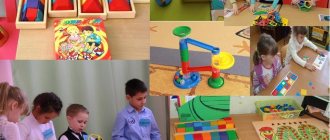Man, as a social being, needs constant communication with others. In order to live fully, many of us need to have a family. In social science, a family is understood as a small social group based on marital relations, consanguinity, mutual responsibility, and intimacy. In addition, it is an important social institution that performs many functions. Let's find out what families are like and how they differ from each other.
Amount of children
Based on the number of children, there are three types of families.
- A childless family consists of spouses who do not have or do not want to have children.
- A small family is distinguished by the presence of one or two children.
- A large family includes three or more children.
Rice. 1. Large family.
Educational and household
In short, the educational function of the family is to transfer knowledge and experience to the next generations, which contributes to the socialization of the individual. In the first years of life, a child learns patterns of behavior, reactions, and norms by observing his parents. Finding himself in other social groups, he gains experience communicating with peers, older and younger.
The economic function of a family consists of its ability to:
- solve everyday problems (cleaning, cooking, repairing furniture);
- maintain your own budget, that is, rationally distribute available funds;
- care for incapacitated members (children, elderly people, disabled people);
It is one of the main functions of the family.
Structure and composition
Based on the structure of family ties, families are divided into nuclear and extended families.
- A nuclear (simple) family consists of spouses and their minor children.
- An extended family is another name for a complex, multi-generational family. In addition to parents and children, it may also include other relatives: grandparents, uncles and aunts.
Based on their composition, it is customary to distinguish complete and incomplete families. A complete family consists of both parents and children. The peculiarity of an incomplete family is that only one parent (mother, less often father) is involved in raising children. The reason may be the death of one of the spouses, as well as reluctance to marry.
Family types
There are 3 types of families that have different influences on the social development and formation of the child’s personality.
- Families are close-knit, harmonious, with a high degree of moral orientation. These are socially prosperous families who can and want to raise a child. In case of any difficulties, it is easy to help them.
- Families are coordinated, but periodically unstable, with an average degree of social and moral orientation. These families are preoccupied with their own internal conflicts, so they would like to raise their children, but they cannot always (it does not always work out). Relationships within the family are tense. Parents make many mistakes, the goals of education are seen vaguely, the methods and means of education are not fully understood and are not used to their full extent.
- Families are disorganized, conflict-ridden, with a low degree of social and moral orientation. These are “problem” families. Are asocial or antisocial. There are several subtypes of such families: outwardly calm families, volcano family, sanatorium family, illusion family, “third wheel” family, family with an idol, masquerade family.
Prosperous and dysfunctional families
A person’s entire future life is shaped according to how his parents treated him and each other. Parents are constantly open and must monitor themselves every second and be aware of their parental pedagogical responsibilities. Whether they want it or not, the child systematically correlates his parents’ teachings with their way of life.
Based on the type of relationship, we can distinguish prosperous and dysfunctional families. I propose to get acquainted with this material in the form of a table.
| Group of families | Subgroup | Characteristics of parental attitude |
| Prosperous families | Understanding | Parents accept the child, do not try to change, always try to understand his point of view and build a dialogue. Parents really evaluate themselves and their child. They can protect the child and meet all his needs. |
| Patronizing | Parents adequately evaluate themselves and the child, clearly understand his needs and abilities, but retain the position of leader and power. They do not enter into dialogue and believe that they always have the last word. | |
| Indifferent | Parents only care about the external picture of the family and child. They know little of his inner world and do not want to know more. Children from such families are always outwardly prosperous, but in reality the parents are more busy with their own problems than with their children’s. | |
| Dysfunctional families | Overwhelming | The main methods are prohibitions and orders. The child is rejected. Child-parent relationships are unstable. Although parents believe that they know their child, they cannot predict his behavior. |
| Alarming | Parents are anxious and unsure of themselves and do not know their children. Because of their own insecurity, they are often cruel. Relationships are contradictory. | |
| Detached | Parents are critical in their judgments and adamant, often harsh, and never enter into dialogue. They place increased demands and expectations on the child. At the same time, they are strongly attached to the child. | |
| Rejectors | There is no focus on the child, it’s as if he doesn’t exist. Parents emotionally reject the child and are not interested in his problems or inner world. They don’t know their child well, but, oddly enough, they adequately assume his behavior. |
According to educational potential
Based on the level of educational potential, the following types of families can be distinguished.
Educationally strong family
The educational capabilities of such a family are close to optimal. Attention is paid to the microclimate in the family, the nature of the relationships between its members and the style of family education that has a beneficial effect on the child.
Educationally sustainable
Overall favorable educational opportunities. Emerging difficulties are overcome with the help of other social institutions, such as schools.
Educationally unstable
The incorrect pedagogical position of parents is characteristic. For example, overprotection, authoritarianism, connivance, etc. But at the same time, this position is easily closed and corrected. That is, the educational potential of the family is great, but the results of education require correction in relation to parents and children.
Educationally weak, with loss of contact with children and control over them
Families in which parents, for certain reasons, are not able to raise their children properly. For example, poor health, excessive workload, lack of education and pedagogical culture. Conflicts as such are not noticed, but there is a constant loss of family influence on children. Often the child goes into an informal subculture.
Within this group, several more types can be distinguished:
- educationally weak with a constantly conflicting atmosphere or aggressively negative;
- marginal, that is, families with any social deformations and deviations;
- delinquent;
- criminal;
- psychologically burdened family.
Form of marriage
According to this criterion, two types of families are distinguished. Let's look at their brief characteristics.
- Monogamy in the modern world is the predominant form of relationships. It involves the marriage of one man and one woman.
- Polygamy is a form of family in which three or more spouses marry.
Polygamous relationships are rare nowadays. As a rule, they are rejected by society as outdated and contrary to moral principles. Thus, group marriage, characterized by the presence of several men and women, is common only in the Marquesas Islands. Polygamy is common in Muslim countries. Polyandry occurs in some states of India.
Rice. 2. Polygamy.
Economic and status
The economic function is associated with the ability to provide financial assistance to family members. An example would be support for disabled parents by adult children.
This function also means that the family can accumulate property (movable or immovable), which is then passed on by inheritance.
The status function is that parents are able to convey to their children a certain position that the family occupies in society (for example, nationality, adherence to religion, belonging to a social class).
A number of the above-mentioned characteristics can significantly influence the future fate of the child. Thus, a person born into a family with low social responsibility may end up in an orphanage, engage in vagrancy, and steal. The acquired negative experience can have a negative impact in adulthood: children often repeat the behavior patterns of their parents. People are often able to break this vicious circle only after long work on themselves.
Nature of education
According to this criterion, there are anarchic, authoritarian and democratic families.
- There are no restrictions in anarchist families. Relationships are built on permissiveness.
- The basis of an authoritarian family is the recognition of the authority of the parents. It is believed that the older generation knows better how to live, so all decisions are made by parents.
- In democratic families, the opinion of each member is respected. At the same time, both parents and children are responsible for their actions.
What have we learned?
The family is the most important social institution, a small group based on marriage or consanguinity. Families can be childless, small or large; nuclear and extended; complete and incomplete; monogamous and polygamous; anarchic, authoritarian and democratic; patriarchal, exploitative and partnership.
Previous
Social science Signs of society as a social system - basic and mandatory, functions and types briefly
Next
Social studiesThe sphere of spiritual life - what it is, the structure of the spiritual culture of society briefly (social studies, grade 8)
Nature of distribution of responsibilities
On this basis, families are divided into patriarchal, exploitative and partnership.
- Patriarchal families are also called traditional families. They differ in that in them all household responsibilities are assigned to the woman. The wife's role is limited to running the household, giving birth and raising children. The husband makes all important decisions and is responsible for material well-being.
- In an exploitative family, the woman is responsible for running the household. In addition, she works equally with her husband.
- In partner families, responsibilities are distributed among all members, performed jointly or in turn. Relationships are built on the basis of mutual respect, decisions are made jointly.
In the modern world, partner families dominate in number. This is due to changes in the social status of women. Traditional marriages, based on the leading role of the man, are considered a relic of the past in developed countries.
Rice. 3. Table “Types of families.”
Social functions of the family
| Functions | Content |
| Reproductive | – reproduction of similar individuals. The family reproduces its kind, provides society with replacement people. |
| Socialization | – the introduction of the individual to society. |
| Existential | – ensuring the safety of family members, care. |
| Economic | – is based on the production of material goods and products through common efforts, maintaining economic stability and satisfying needs. |
| Primary social control | – value and ethical standards of behavior within the family in different areas of life. |
| Recreational | – protection, strengthening, restoration of the spiritual, physical component of the individual. |
| Social status | – the acquisition of social roles in society ensures the strengthening of the social structure. |
| Leisure | – organization of free time in the form of entertainment. |
| Hedonistic | – the need for care, love, a feeling of happiness. |
Marriage is a legally formalized relationship between spouses that regulates their rights and functions in family life. In addition, marriage is represented by a social institution that sets the rules of behavior in intrafamily relationships.
Trends in the development of modern families in the Russian Federation
In modern Russia, the following main trends in the development of the modern family can be identified:
1) increasing the age of persons entering into marriage;
2) postponing the birth of the first child;
3) having one child;
4) increase in the number of divorces;
5) the spread of partner-type families;
6) change in the position of women in the family
7) the increase in legally unregistered civil marriages and children born in them;
 reduction in the number of traditional (patriarchal) families.
reduction in the number of traditional (patriarchal) families.
9) transition from extended family to nuclear
At the beginning of the 21st century. requirements for the family are increasingly increasing, but this institution continues to remain one of the most basic and
necessary not only for society as a whole, but also for each individual individual.
In modern conditions, a special role in the development of family relations can be played by the state, which is interested in preserving and strengthening the institution of the family. In recent years, demographic and family policies have been considered as an unconditional priority of social policy in Russia.
Population policy
— policy in the field of population development, not only quantitative growth, but also ensuring the quality of human life in our country.
Depending on the relationship of the spouses
There are also several types of marriages depending on the relationship that develops between the spouses.
- Dictator families. All important decisions are made by one member of the couple, while the other may only be responsible for resolving minor issues.
- Democratic families. The most unstable. This type of relationship is most often characteristic of newlyweds. The couple tries to resolve all issues together and make concessions to each other. However, more often than not, one partner thinks they are giving more and getting less.
- Autonomous families. In this case, the couple strictly demarcates the spheres of influence. A man is responsible for one thing, a woman for another.
Typology depending on the main function
Different types of families and their characteristics are a topic that will be discussed further. What other types of marriage relationships exist?
- Patriarchal family. Its main goal from this perspective is running a joint household and achieving economic well-being.
- Child-centric family. Here the main task of the couple is to raise children and prepare them for public life. However, often such families cross an unacceptable line when the younger generation turns out to be dependent and spoiled.
- Married family. Sociologists say that this is the relationship of the future. Its main goal is the emotional satisfaction of the spouses. Most often, such families do not have children and live their whole lives to satisfy their needs and desires.










